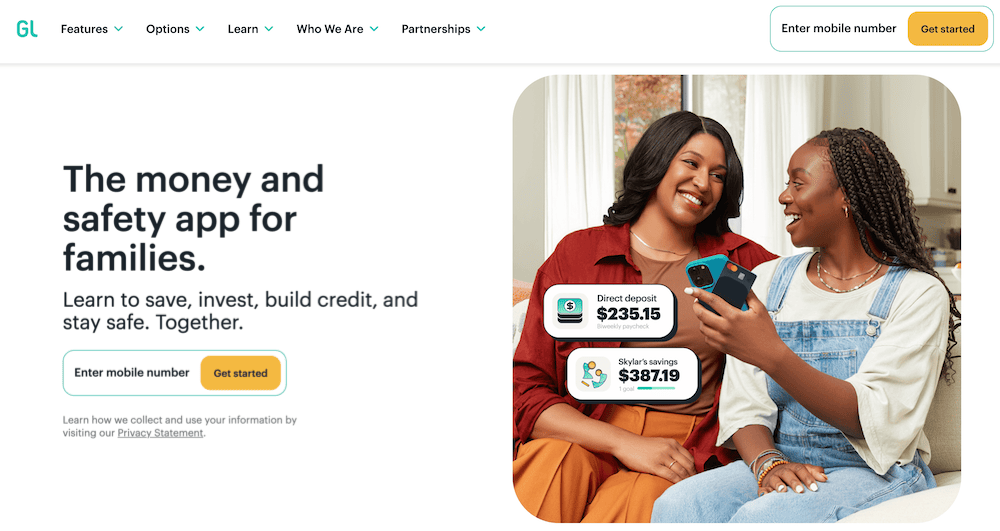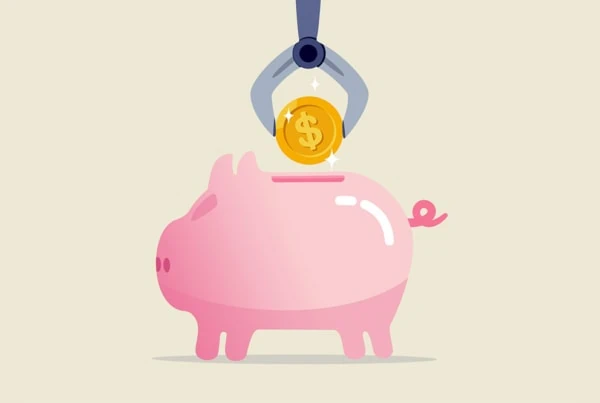Opening a bank account is one of the most important tasks for any young person. The first time you do it, you will be asked how old you are and how much money to deposit. But how old do you have to be before being able to open a bank account?
With this article, we cover the rules and regulations you need to know when opening a bank account, including how old you have to be, the documents you need and the process for opening a bank account to enable child banking.
When setting up a bank account, it’s best to be prepared and start by coming into the branch or opening an account online. Continue reading to learn what you need to do to open a bank account.
Table of Contents
Looking for a Bank Account for Minors? Consider Greenlight
- Greenlight is a financial solution for kids that allows them to spend with a debit card, earn money on savings, and even invest their money.
- Greenlight offers flexible parental controls for each child and real-time notifications of each transaction. And it's the only debit card that lets you choose the exact stores where kids can spend on the card.
- Parents can use this app to teach kids how to invest with a brokerage account through Greenlight Max and Greenlight Infinity plans.
- Families can earn 2% (Core), 3% (Max) or 5% (Infinity) per annum on their average daily savings balance of up to $5,000 per family. Also, Max and Infinity families can earn 1% cash back on their monthly expenditures.
- Unlike many apps that simply provide features and controls, Greenlight is also designed to spark discussions with children about spending, investing, and more, fostering a better educational experience.
- Best-in-class parental controls (can prohibit specific stores)
- Can add brokerage account to invest in stocks
- Intuitive Parent + Kid apps
- Competitive cash back & interest rates
- Parent-Paid Interest
- High price points
- No cash reload options
- No parent / child lending
Am I Eligible to Open a Bank Account?

To be eligible to open a bank account, you need to meet certain requirements. Most U.S. banks require you to be:
- A U.S. citizen
- 18 or older (an adult)
- Have a government-issued ID
- Make a minimum opening deposit (and maintain certain balance requirements)
- A co-owner if you’re not of legal age
How Old Do You Have to Be to Have a Bank Account?

Opening bank accounts requires you to be of an eligible age. You need to be at least 18 years old to open an account by yourself, or the age of majority in your state of residence. One way around this requirement comes from opening a joint account with at least one of the account holders being the age of majority. Typically, this is a parent or legal guardian.
Likewise, you can also apply for accounts specifically targeted toward minors looking to open a bank account, but this still requires a parent or legal guardian to serve as one of the account holders. These accounts allow the adult to manage the account while also teaching the minor owner about banking.
Before applying for an account, you want to check with your potential bank of choice to determine the eligibility requirements for opening an account. Also be sure to examine the fees, like a monthly maintenance fee or service fee, and other associated charges assessed by the bank. You don’t want to get hit with overdraft fees or late payment charges and a bank might turn you away if you have a history of them.
In some cases, banks may run a background or criminal check to assess if you have participated in any financial crimes.
As another consideration, you may need to be a U.S. citizen to open a bank account in the United States.
In the event you apply for a credit card, the financial institution will also take a look at your credit history and credit score. The type of credit card you apply for may require you to have a decent credit score to open the account. Though, some credit cards target individuals looking to build or rebuild credit, making you eligible without a good score or any history at all.
Related: Best Credit Cards for Teenagers
Featured Financial Products
How to Open a Bank Account as a Minor
Children cannot open bank accounts in their own names because they are not legally capable of entering into contracts yet. A parent or guardian must open the account and be listed as joint owners with their minor child.
The steps you need to take for opening accounts will vary depending on the financial institution. However, according to general procedures for how to open a bank account for a minor, these steps should generally allow you to open a bank account for your children.
How to Open a Bank Account for a Minor
1. Choose the Type of Account You Want (Checking Account vs. Savings Account)
Banks commonly offer checking and savings accounts for kids these days, and increasingly, they’re combined with banking apps for kids and teens.
Here are some of the most basic types of account you’ll come across:
1. Savings Account
- Best for: newborns and young kids with a long time horizon.
Savings accounts allow you to deposit money and earn a modest amount of interest for money held in the account. These accounts carry Federal Deposit Insurance Corporation (FDIC) coverage worth $250,000 (insurance on your bank account deposits in the event your institution faces financial problems), representing a safe place to store money and earn interest.
2. Checking Account
- Best for: teenagers starting to manage their own money.
A checking account is another bank account that allows you to store money–but it also provides easy access for using your money. These accounts, which also carry FDIC insurance, usually come paired with a debit card and check-writing privileges.
Some accounts have monthly minimum balance requirements and charge service fees. Minors should look for checking accounts with minimal or no fees if possible.
3. Prepaid Debit Card
- Best for: people first learning about managing money.
If we’re being technical, a prepaid debit card is a “stored value” card that works similarly to a gift card. A prepaid card allows you to spend only the money stored on the card, and nothing more—unlike a credit card with a line of credit you borrow against as you spend.
They have their benefits. Prepaid debit cards prevent overdraft fees, thus helping you avoid the costly pitfalls of spending too much or overextending yourself financially. You can’t spend more than you have, and you don’t get penalized for trying.
4. Custodial Account
- Best for: parents who want to open a bank or investment account for a minor.
A custodial account is a savings account an adult manages on behalf of a child under a certain age (usually, 18, 21 or 25, depending on the state). Any financial assets held in the account are owned by the account beneficiary (the minor). These accounts allow adults to make transactions within the account, such as buying and selling investments or saving money for the benefit of the minor.
Custodial accounts allow you to save for future expenses ranging from college or a car to a wedding or even a down payment on a home. Custodians have a fiduciary responsibility for managing the assets held in the account, meaning they are bound ethically and legally to act in the best interests on behalf of the minor.
5. Roth IRA for Kids
- Best for: kids with income looking to grow their money for a long time.
A custodial Roth IRA for kids is a retirement account that allows your child to set aside earned income toward retirement.
Kids can pay lower income taxes now as they contribute to the account–then the money will grow tax-free in the account, and they won’t be taxed when they withdraw their funds in retirement. Those decades of tax-free growth make Roth IRAs a powerful way to leverage compounding returns to a child’s benefit.
There’s an App for That
Restrictions might apply from one banking institution to another. For instance, teenagers generally only have access to kids checking accounts. Regardless of what type of account you pick up, you’ll want one with a feature-rich app.
For instance, with apps such as Greenlight, you can establish parental controls to monitor, manage and shortlist where your kids shop online and offline alike.
Further, you have the ability to assign chores and disburse allowance payments, automate money transfers, offer Parent Paid Interest (this is like the yield that you would earn in a savings account, but instead, it flows from your parental account into your child’s account at rate you determine later), and much more.
Many of these money apps for teens come equipped with useful financial literacy tools for you to teach your kids solid money management.
Featured Financial Products
Related: Best Debit Cards for Kids
Do Your Due Diligence

Deciding the account type you want is an important step. Once you settle on this decision, you’ll need to look at which providers make the most sense for your needs.
As with many products geared toward kids, there are myriad kid-focused account providers to choose from. And that can make it challenging to identify which one makes the most sense for your needs.
Banks, credit unions, even fintech companies will offer many of the same account features, but maybe not all of them. So your job is to determine which account features are most important to you and your child.
Among the features to consider:
ATM Networks
You can typically use an ATM card at any cash machine–but if it’s out of your bank’s network, you’re going to pay. A large network means you’re less likely to incur those fees.
Of course, your child might not ever need to withdraw money several states away, in which case, a large ATM network might not matter–just one that has a few machines in your area.
Branch Locations
This is a similar idea to the ATM network, but instead of allowing you to merely withdraw or deposit cash, branches provide a wider array of services.
You might or might not need a high number of branch locations–but you probably want at least one or two conveniently located branches that are easy to visit.
App Functionality
When comparing apps, you’ll want to examine both ease of use (who wants a hassle just trying to check their account balance?) and the app’s tools and functions.
Do you want to be able to limit your child’s spending capabilities, or maybe deposit checks online? Make sure your bank’s app can do all you want it to do.
Interest Rates
We frequently tout the importance of teaching your child about the power of compound interest. Why not give them a practical example that grows their money over time?
Sure, no one will get rich off the interest in their checking or savings account, but more is more–consider looking for a competitive interest rate from your child’s account.
Access to Feature-Rich Debit Cards
All cards are not created equal. Some cards boast features such as parental controls over where their kids shop, or how much they spend. Some also offer purchase notifications and even purchase requests.
Thus, you should make sure the debit card you get has the features that are right for you and your child.
2. Submit an Application

Once you’ve chosen a bank and an account that fits your needs, it’s time to apply–which means you’ll need to submit an application with you as a joint account owner.
The good news is that while some banks and credit unions might make you visit in person to open a kid’s banking account, others will allow you to open a minor’s bank account online. Same thing with several fintech apps.
Either way, the application process should only take about 10-15 minutes. And there are several things you can expect from the process that should be the same no matter what.
First off, you’ll need to provide some sensitive information about yourself. So make sure you have a secure internet connection, and that your financial institution offers a secure web portal.
Be especially careful that you’re not being led to any fake or spoof sites with similar names as your intended bank, credit union or fintech firm.
After verifying you’re in the correct place on a secure connection, you can proceed with the application. The bank will ask a series of questions meant to verify your identity.
This means you’ll need to supply your target bank with some necessary information when you’re opening an account. This includes:
- Your name
- Address
- Date of birth
- Social security number
- Valid government-issued ID
If you’re opening a bank account for your minor online, you’ll provide this information in text box forms found on the website.
If your web browser auto-populates forms with your personal details, make sure they appear in the correct locations on the application. You don’t want your information to appear where your child’s should, or vice versa.
Once you’ve submitted all the requested information, the financial institution will process your application. At this point, your history with other bank accounts is likely to come under review.
Your application will trigger your bank to request information on your banking history by contacting an account verification service such as ChexSystems, a consumer-reporting agency that serves a similar purpose as the major credit reporting bureaus (Experian, TransUnion and Equifax), but for bank accounts.
The agency will create your Consumer Disclosure report–a document containing information about your financial history and any problems you might have had with previous bank accounts.
The agency looks for derogatory marks that might exist on your checking and savings accounts, which you would have picked up from, say, paying late fees, bouncing checks or experiencing fraudulent activity. (The process is similar to when a credit card company processes your application for a credit card and reviews your credit score provided by the credit reporting bureaus.)
ChexSystems assembles the provided information on your Consumer Disclosure report to calculate a risk score–which ranges from 100 to 899, where higher scores are better–based on your consumer banking history. Based on this score, the banking institution will decide whether they will allow you to open an account with them. (Note: Running one of these reports doesn’t ding your credit report with an inquiry.)
If you’d like to access your ChexSystems consumer report, you can get a free copy every 12 months through the ChexSystems site.
If you’re approved for your account, the next step involves funding the account.
3. Fund the Account and Activate the Debit Card

As a condition for opening a joint account with a minor, you often need to fund the account as part of the final stage of the application process.
Placing funds into your child’s account can usually be done with a debit card or credit card, or even a direct transfer from an existing bank account. Some restrictions may apply depending on the institution.
If you opened a checking account, your account might come paired with a free debit card or bank card your kid can use to make purchases or withdraw from their deposit accounts.
Note that while some banks and credit unions offer temporary cards immediately, your actual card could take one to two weeks after application approval to arrive. When the official debit card arrives, you likely will need to activate it via telephone (by a toll-free number provided on the card) or online through a secure web portal. However, increasingly, many modern banking apps will allow you to activate the debit card through a smartphone app–and even “carry” it in a digital wallet such as Apple Pay (age 13+) or Google Pay (age 16+).
If your bank, credit union or other financial institution offers a mobile app with your bank account, you should strongly consider downloading it on your phone. Apps allow you and your child to check the children’s savings account balance and monitor any account fees, transactions and more. Further, you can use these mobile apps to monitor account activity or restrict access to funds.
Several of today’s most popular apps, including Greenlight and Copper, let parents assign chores and pay allowance through the app with just a few taps.
What Do You Need to Open a Bank Account Online?

Now, you can open a banking account with debit card for your child with a few clicks of a button, thanks to digital systems and fintech apps.
As part of the U.S. Patriot Act, the government requires financial institutions to help fight the funding of terrorism and money laundering activities. Therefore, federal law requires all financial institutions to obtain, verify, and record information that identifies each person who opens an account.
For you, this means you’ll need to supply your target bank with some necessary information when looking to open an account. This includes information like:
- Your name
- Address
- Date of birth
- Social security number
- Valid government-issued ID
To open an account with banks like Wells Fargo, Bank of America, U.S. Bank, or Capital One, a deposit account with a credit union, or even mobile banking apps like Greenlight, you will need to supply a handful of important pieces of documentation.
Afterward, your kid can start making deposits into these joint accounts, working toward financial goals, using a paired ATM card and managing their money.
While what you need may vary by institution, but the information above will be standard requirements. The account holder will need to provide all or some variation of the above items the joint account held between the minor and parent or guardian with the following documents:
- Your driver’s license
- Your Social Security number
- Your child’s Social Security number (potentially a Social Security Card)
- Your child’s birth certificate
- Proof of address (usually a utility bill)
Featured Financial Products
How Do Banking Apps Work?
While branded as a banking app for kids, these bank accounts work the same way they would for adults, except parents also have access to the account.
Both children and parents have online account access and these apps allow children to log into their own sub-accounts, like an authorized user on a kid’s credit card. These sub-accounts carry fewer features than the adult version because you can set specific limits on how funds get spent, managed and saved.
These banking apps come with debit cards with parental controls and allow you to fund money through transfers from existing checking accounts.
Grown-ups can monitor, limit and pick specific locations where cards can get used.
These apps for kids also help with letting your kids save money in what has become their virtual piggy bank.
Should I Open a Savings Account for My Child?
Banking apps for kids can assist them in learning the value of money. This means teaching kids to save money.
They can be set up with targets for saving and the app will show them how much they have saved, what their target is, and when they’ve hit it.
Some apps teach children about budgeting by having a spending limit that parents approve before each purchase or an allowance amount based on age. Some of these banking apps also provide financial literacy resources to teach kids about money. And some apps even allow teens to save for certain expenses like summer camp, a prom dress or college tuition.
These apps can allow the teen to set up teenager money goals with milestones and it will let them know when they’ve hit the goal in an easy-to-read pie chart layout that breaks down where their saved funds go.
Done consistently and through repetition, these apps can help kids with things to save up for as well as how to manage their funds for the long-term.
Where Can I Open a Bank Account for My Child?

In today’s environment, you have several options available to open bank accounts for your children.
You can either choose a traditional bank or credit union, one that offers banking products for children. More modern options like online banks also offer savings accounts and checking accounts while some companies are making it easy to open an account with them by partnering up with schools. Some even come complete with their own debit cards so kids can start using the money with the supervision of their parents.
Some banks offer a special teen checking account where you and your child act as the account owner because you are joint account holders.
Minors can’t legally have bank accounts in their own name, meaning your name must also sit on the title to the account.
Best Bank Accounts for Child Banking
Compare these best online bank accounts for kids that let them save, spend and learn how to manage their money.
1. Greenlight Card

- Available: Sign up here
- Price: Core: $5.99/mo. Max: $9.98/mo. Infinity: $14.98/mo. (All plans include cards for up to 5 children)
Greenlight started as a money app for teens focused on helping kids manage their money while establishing parental oversight.
Greenlight works like a prepaid debit card. You can choose how much money to load onto the card and it will be cleared to make approved purchases so long as a money balance backs up the card. Teenagers who have jobs can add their own funds to the card as well.
But Greenlight provides parents with control over where their teens can spend money by limiting the stores where their cards work. Parents also can receive alerts when money is spent. Teens who want extra money can request it and even include a photo of the purchase they want to make.
Greenlight also has numerous safety features. Your child needs permission to move money out of the account. Further, Greenlight encrypts data and pictures of your child, preventing that information from being accessed by anyone but yourself. Each Greenlight card comes with a PIN number (like a traditional debit card). And every account is FDIC-insured.
The Greenlight card is accepted at any ATM that accepts Mastercard, Visa, Interlink or Maestro cards. (Just note that most ATMs charge withdrawal fees, and these fees will be charged per withdrawal.)
The Greenlight debit card for teens is a good choice for parents interested in teaching kids about money, including the importance of saving money and being prudent with their personal finances. It can also be used to build teenage money management skills. This financial product can be an effective learning tool for helping kids to understand why saving should be a priority. It can also be used to simplify paying an allowance or tracking chores.
Consider Greenlight’s debit card if you want to have control over what your kids buy and also teach them about responsible spending.
- Greenlight is a financial solution for kids that allows them to spend with a debit card, earn money on savings, and even invest their money.
- Greenlight offers flexible parental controls for each child and real-time notifications of each transaction. And it's the only debit card that lets you choose the exact stores where kids can spend on the card.
- Parents can use this app to teach kids how to invest with a brokerage account through Greenlight Max and Greenlight Infinity plans.
- Families can earn 2% (Core), 3% (Max) or 5% (Infinity) per annum on their average daily savings balance of up to $5,000 per family. Also, Max and Infinity families can earn 1% cash back on their monthly expenditures.
- Unlike many apps that simply provide features and controls, Greenlight is also designed to spark discussions with children about spending, investing, and more, fostering a better educational experience.
- Best-in-class parental controls (can prohibit specific stores)
- Can add brokerage account to invest in stocks
- Intuitive Parent + Kid apps
- Competitive cash back & interest rates
- Parent-Paid Interest
- High price points
- No cash reload options
- No parent / child lending
2. Acorns Early / GoHenry (Best for Customer Service)

- Available: Sign up here
- Price: Acorns Early: $5/mo. for 1 child. $10/mo. for 2-4 children. Acorns Gold: $12/mo., includes Acorns Early for up to 4 children.
A longtime player in the kids’ debit card/financial app space has a new name and a new face: GoHenry, which was acquired in 2023 by Acorns, has officially become Acorns Early.
Many reviewers have long painted Acorns Early/GoHenry as just a way to spend. However, I see it as a real financial solution for minors—a debit card, yes, but also an app-based ecosphere that provides education and experience for the child, as well as ways for parents to keep their kids safe and teach them responsibility.
When you open an Acorns Early account, each child receives an Acorns Early Mastercard debit card that can be used anywhere Mastercard is accepted (so, millions of vendors), online, in stores, and even in ATMs. An Acorns Early account also allows kids to set savings goals, which they can fund manually or via autosave. And it also hosts educational materials to help children and teens alike develop good money habits.
This FDIC-insured account also enjoys a variety of safety features, including chip and PIN protection, secure PIN recovery, and Mastercard’s Zero Liability Protection, which means your child won’t be liable for fraudulent purchases as long as they take care in protecting your card from theft and you promptly report any fraudulent activity.
Acorns Early also offers parents additional peace of mind by providing a number of controls, including:
- Real-time spending notifications
- Card lock/unlock
- Savings goal lock/unlock
- Adjustable spending limits on a per-transaction and per-week basis
- Card category block/unblock for in-store purchases, online purchases, and ATM withdrawals
- Adjustable spending block/unblock at stores that sell age-restricted goods such as firearms and alcohol
Also, kids can only spend whatever money is available on the card because it’s a prepaid debit card. That means parents don’t have to worry about costly overdraft fees or their kids running up a debt.
Acorns Early doesn’t allow kids to invest. However, an Acorns Gold subscription comes with not only a free Acorns Early account for up to four children, but also the ability to open an Acorns Early Invest custodial account, which you can use to invest toward your kids’ future.
GoHenry really stuck out to us as one of the best prepaid debit cards for kids because of their outstanding customer service. Good news there: Acorns Early users should expect a similarly high level of customer support, including seven-day-a-week phone service from 5 a.m. to 7 p.m. PT, as well as 24/7 live chat support.
Acorns Early has no minimum age requirements but recommends starting at age 6 or older. Sign up for an Acorns Early account or Acorns Gold to get started today, or read our Acorns Early review to learn more.
A note for current GoHenry users: For now, your app, features, and cards will continue to work as normal. However, if you want all of the latest features, you’ll need to download the Acorns Early app from the iOS App Store or Google Play.
- Acorns Early (formerly GoHenry) is a debit card and financial app designed to provide education, experience, and confidence in saving, spending, and earning, to kids ages 6-18.
- Kids get a Mastercard debit card that allows them to spend in stores and online, and withdraw money from ATMs.
- Kids can also earn allowance, complete chores for money, set savings goals, even give to charity.
- Parents can rest easy knowing there are plenty of guardrails in place, including chip-and-PIN technology, Mastercard Zero-Liability Protection, and parental controls such as spending notifications, card locking, and adjustable spending limits.
- Acorns Early also provides educational resources tailored for kids of all ages.
- GoHenry's reputation for excellent customer service among kids' debit card providers will continue through Acorns Early, which is offering everyday phone availability and 24/7 chat support.
- Subscribing to Acorns Gold includes not only a free Acorns Early account for up to four children, but also Acorns Early Invest, a UGMA/UTMA custodial account where you can save toward your kids' future and get a 1% match on up to $7,000 in contributions annually.
- Special offer: Get a free 30-day trial and $5 allowance when you sign up.
- Strong parental controls (including card-use controls and adjustable spending limits)
- Chores and allowance
- FDIC insurance
- Allows for ACH payments
- Convenient "Giftlinks" for non-accountholders to give money to kids' accounts
- Customizable cards ($5-$6)
- No investing feature
- No fee-free ATM network
Related: Acorns Early (Formerly GoHenry) vs. Greenlight
3. Copper Card

- Available: Sign up here
- Price: Free 30-day trial. Copper: $4.95/mo. Copper + Invest: $7.95/mo. (All plans include cards for up to 5 children)
Copper Banking was founded on the belief that kids and teens should have equal access to financial education and should be empowered to learn by doing. Now, the company is on a mission to help children gain real-world experience by giving them access to their money in a way that traditional banks can’t.
The Copper app and debit card teaches your child how to make smart financial decisions by creating a platform where parents and their kids can connect. With the Copper app, you get easy snapshots of your accounts. And with the Copper Debit Card, it’s easy to shop in-store or online, including with Apple Pay or Google Pay.
Plus, users get exclusive access to engaging advice curated by a team of financial literacy experts who provide tips on how to take control of their financial future.
The basic Copper account includes the above banking features. With Copper + Invest, your child also gets access to automatically curated smart portfolios built with their preferences in mind. Your child is given a questionnaire that helps Copper determine a portfolio based on their age, income, net worth, investment objective(s) and investment horizon. Copper then recommends one of three ETF portfolios—Moderately Aggressive, Aggressive, and Extra Aggressive—made up of thousands of stocks. Parents can review the portfolio to ensure it matches with not just your child’s preferences, but your family’s. (Portfolios can be changed later on by accessing the Support chat.)
Your child can begin investing for as little as $1, then add more contributions down the road. Copper will automatically rebalance the portfolio as needed to make sure it always keeps up with your child’s investment preferences.
Copper is available to kids 6 years and older.
Read more in our Copper Banking review.
- Copper is the digital bank and debit card for teens built with the mission of creating a financially successful generation.
- Send/Request: Teens and parents can easily send and receive money all at the touch of a button.
- Spend: Pay with a digital wallet via Apple Pay or Google Pay or use the physical Copper Debit Card.
- Monitor: Get a snapshot of all your spending in an easy-to-read dashboard.
- Save: Gain quick snapshots of your savings and helpful tips on how you can save even more. Set up savings bucks and save for the things that you want.
- Learn: With the help of Copper's team of financial literacy experts, learn more about how to maximize your money and prepare yourself for your financial future.
- Allowance administration
- Financial education resources
- Network of 55,000-plus fee-free ATMs
- No chores tracking or assignment
- No parental controls beyond notifications
What Is a Custodial Account?

A custodial account is established with a parent’s money and the child is the account holder, meaning they have full ownership over the funds held in the account.
You can open custodial accounts, also known as UGMA (Uniform Gifts to Minors Act) and UTMA accounts (Uniform Transfer to Minors Act), to establish savings and investments for your minor children. Many use these accounts to teach kids about money management but also to invest on their behalf for future expenses like college, a wedding, car or housing down payment.
One potential downside of a custodial account is that once the funds get deposited into the account, they become irrevocable gifts, meaning you can’t take the money back. While not a problem in most circumstances, this can be a sticking point for some individuals and should be something to be mindful of with custodial accounts.
After reaching the age of majority, custodial accounts transfer to the account owner and no longer have a custodian manage the funds in the account. Further, since the funds in these accounts technically belong to the account holder, they carry a higher financial contribution weight when deciding financial aid eligibility for college.
Federal financial aid formulas consider 20% of the money in the account as funds available to pay for college. When compared to 529 plans established by a parent or legal guardian for the benefit of the minor, these provide less favorable conditions to receive financial aid.
The Free Application for Federal Student Aid (FAFSA) formula considers a maximum of 5.6% of the money held in a 529 plan to be available for college. The money held in these accounts classifies as an asset of the parent and not the child, despite the child’s Social Security Number appearing on the account title.
Featured Financial Products
Related Questions on Child Banking
Can a 12 Year Old Have a Checking Account?
Yes, though they need to have a parent or legal guardian as an account co-owner. They cannot open one by themselves.
Can You Open a Bank Account at 16?
Yes, though you again will need to have a parent or legal guardian as an account co-owner. You cannot open one of these accounts as a minor because you cannot legally enter into contracts as a minor.
Can a 16 Year Old Open a Bank Account Without Parents?
Not exactly. You cannot open an account without parents or a legal guardian, though you can open a joint account with someone you trust who is the age of majority.
Can I Open a Bank Account at 17 By Myself?
Technically, no. Not by yourself. A minor requires a parent or legal guardian (or someone the age of majority) to serve as a joint owner on a bank account.
How Do I Open a Bank Account at 17?
You can open an account with the steps listed above and the help of a parent or legal guardian.
Are There Tax Implications to Opening a Bank Account for Kids?
Yes, you may face tax implications for having a bank account or custodial account which pays interest or other investment income. This applies to any unearned income, including interest, dividends or capital gains.
The taxes you face depend on the type of account you set up, but all follow the same Kiddie Tax rules by the IRS with respect to unearned income.
- Savings accounts. If your child makes more than $2,600 in unearned income (interest income in this case) in a given tax year, you and they may need to pay taxes.
- Custodial accounts. If a UGMA or UTMA account makes more than $2,600 in unearned income from interest, dividends or capital gains in a year, the minor and yourself will likely need to pay taxes.
- Trust funds. Minor beneficiaries and other beneficiaries of a trust fund are responsible for paying taxes on any unearned income produced and distributed by the trust. Trusts may be subject to taxation if distribution is made. If you’re considering setting up a trust fund, consider visiting Trust & Will to learn more about your options and how a trust will be taxed.
Can You Gift Money to a Child’s Account?
As of 2024, you can gift up to $18,000 per year to a single person without needing to document the financial gift with the IRS. This means you can learn how to gift stock to a UGMA account without paying any extra taxes. If you have a spouse, they can also gift up to $18,000 per year.







![Check Out the New 401(k) Contribution Limits for 2026 [Save More for Retirement] 34 number blocks switching from 2025 to 2026.](https://youngandtheinvested.com/wp-content/uploads/2025-to-2026-blue-background-1200-600x403.webp)

![7 Best Microsavings Apps [Save Money, Reach Your Goals] 36 best microsavings apps](https://youngandtheinvested.com/wp-content/uploads/best-microsavings-apps-600x403.webp)
